Intel 925X Roundup: Creative Engineering 101
by Wesley Fink on August 12, 2004 12:05 AM EST- Posted in
- Motherboards
DirectX 8 & Open GL Gaming Performance
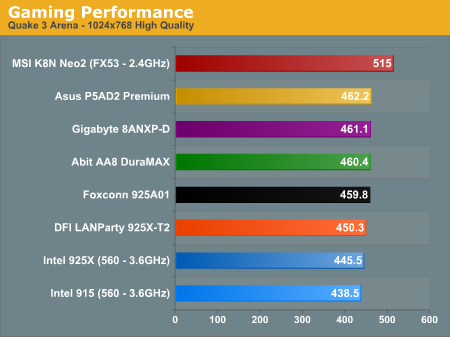
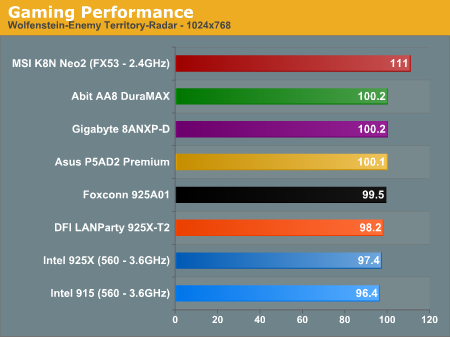
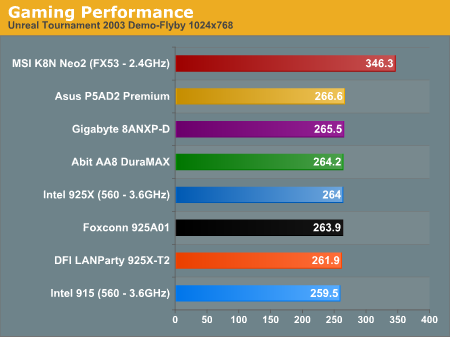
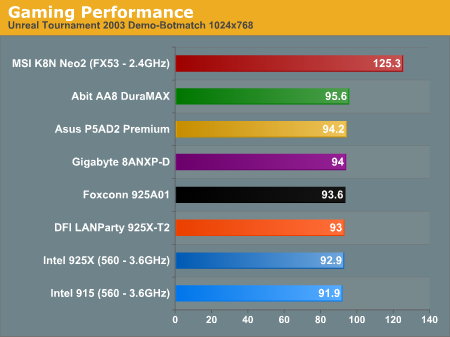
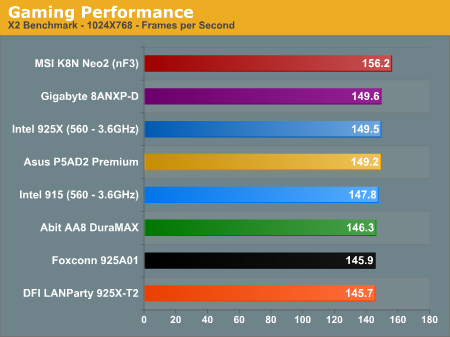

The same pattern of Asus and Gigabyte topping the gaming charts is seen in DirectX 8 and Open GL games, but in these benchmarks, they are joined by Abit. These three motherboards top the benchmarks for all 6 DX8/OpenGL games. We still see Gigabyte and Asus in the top few positions of the boards tested in all the benchmarks.
The biggest surprise in the roundup is the rather average performance of the DFI LANParty at stock speeds. Perhaps this has to do with the tested board being a very early production sample. As you can see, test results of the DFI generally top Intel, but they are toward the bottom of results compared with these five boards. We have seen reports of incredible overclocking with phase-change cooling on the DFI, and we wonder if the slightly more relaxed results at stock speeds may be part of what will likely end up as one of the better overclocking boards using the 925X/915 chipset. We will withhold final judgment until we get a chance to evaluate a release production board with all the final tweaks and a finished BIOS.










30 Comments
View All Comments
johnsonx - Thursday, August 12, 2004 - link
What is it with you people griping about CPU choices? This is a review of current top-end 925X boards, not a CPU review! The FX-53 scores are there only for a point of reference. Added to that, Wesley's point is VERY valid: the 560 and FX-53 ARE the top CPU's from each camp.If you really want to know how a 3800+ would perform, refer to past Socket-939 reviews, or just mentally subtract about 3% or so.
STOP WHINING!
Wesley Fink - Thursday, August 12, 2004 - link
#17 - Since we were trying to determine the maximum overclocking ability of the boards tested, we used a 3.6 ES LGA 775 Prescott at a 14 multiplier (2.8Ghz). The 14x280 is close to 3.9GHz speed. We also checked with a retail 540 (3.2GHz) and reached 250FSB (4.0GHz) at 1.45V.These results lead us to believe that many 775 Prescotts will top out at 3.9 to 4.0GHz on boards that will support those overclock levels. That means that there are likely some 2.8 Prescotts out there that can reach 280FSB.
As always, overclocking is variable, and you need a really great power supply and decent cooling to support the power requirements at these kinds of overclocks.
Carfax - Thursday, August 12, 2004 - link
Wesley, is it possible to do a review of Prescott which focuses on the upcoming 1ghz FSB? I've heard that Prescott scales better than N.W with a higher FSB and greater clockspeed..To do the review correctly, you'd need an engineering sample with an unlocked multiplier, so you can see the benefit of the increased FSB, without raising the clockspeed.
I think Prescott would do pretty well on 1066FSB and with fast DDR2 memory..
danidentity - Thursday, August 12, 2004 - link
Wes,When you say you hit 280 FSB with the Asus P5AD2, was that with a retail chip, multiplier locked? Or were you using an ES chip. If you were using a retail, that is an absolutely insane overclock.
danidentity - Thursday, August 12, 2004 - link
>> Better than comparing a 3500+ to a 3.6F anyway :PHow would a 3500+ compare with a Intel 3.6? Could it hang? :)
RyanVM - Thursday, August 12, 2004 - link
I have no problem with the 3.6E and FX53 being shown together since both platforms will end up costing about the same (factoring in CPU, mobo, and memory costs). Prices fluctuate, yes, but both companies (OK, mainly AMD) tend to adjust prices to stay in line with performance levels (if Intel drops the 3.6E price, I'd put money on AMD dropping prices at the high end within a day or two).Better than comparing a 3500+ to a 3.6F anyway :P
Creig - Thursday, August 12, 2004 - link
#12/#13 Given the way pricing can fluctuate, it would be futile to compare Intel $$$ to AMD $$$. A couple of days after the article was published, pricing could change to make the monetary comparison useless and therefore misleading.I think they're doing it the correct way. It's up to the end user to find his/her best balance between performance and price.
mjz5 - Thursday, August 12, 2004 - link
man, i should of read #12 first before posting it.. why not have an edit button?anyhow, u all know what i'm saying!!!
mjz5 - Thursday, August 12, 2004 - link
the way i see it is that CPUs should be compared by price. If an AMD FX-53 cost as much as a Celeron 2.4 GHz, why not compare the two? If someone is going to looking at these products because they cost X dollars, they aren't interested in seeing that an Intel CPU that cost (X*2) may or not surpass it the competitor at only X dollars.Wesley Fink - Thursday, August 12, 2004 - link
#9 & #10 - Corrected